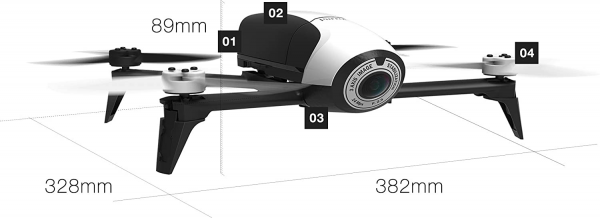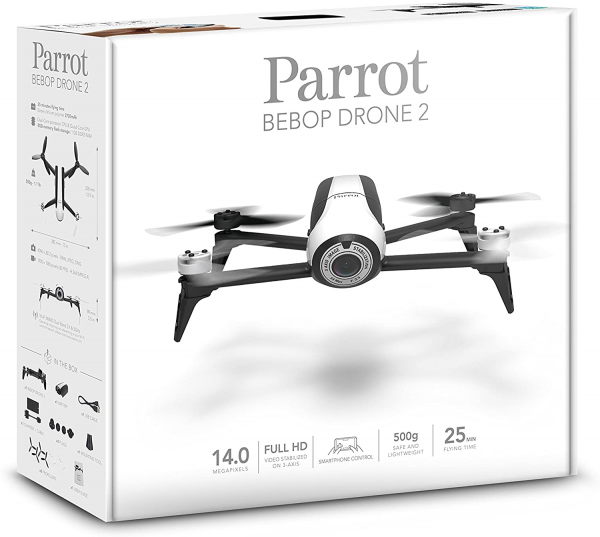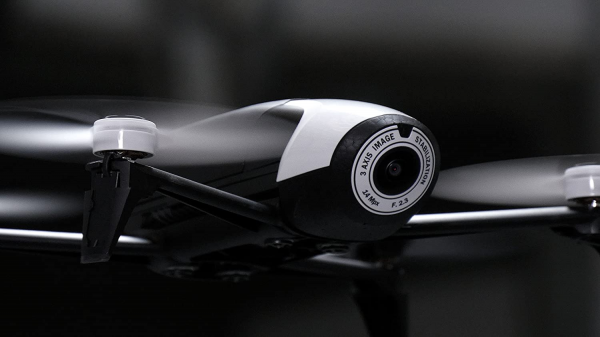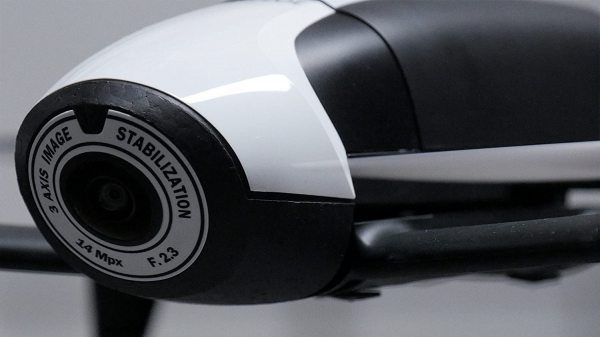Parrot
Parrot Bebop 2: rock-solid stability
Aprox. 319€
See specificationsVery small, cute, the Parrot Bebop 2 is a drone intended for the widest possible audience. Here, special emphasis has been placed on stability, both in flight and that of the image. This French quadricopter equipped with an integrated fisheye lens covering 180 ° and opening at f / 2.3 imposes by its ease of handling ... at the price of a very perfectible image quality.
Positive points
Lightness (500 grams).
Ease of handling.
Stability in flight.
Maneuverability.
Intuitive controls.
Image very well stabilized.
Autonomy (25 minutes).
Solidity.
Bad points
Image quality level with that of an entry-level action cam.
Few settings in video and photo.
Video limited to Full HD 30p.
Sensitive to ground effect.
Wi-Fi connection sometimes recalcitrant.
Our review
Presentation
Second generation of the Parrot Bebop, the Bebop 2 is a bit overweight: 25% heavier for a total of 500 grams, 4 centimeters longer, 6 centimeters wider. But it's for a good cause: the battery is more than doubled, going from 1,200 mAh to 2,700 mAh with the promise of 25 minutes of autonomy, a more powerful engine, not to mention a vertical camera, an ultrasonic sensor, a barometer, a gyroscope, an accelerometer and a magnetometer all used to improve stabilization and, in fact, ease of handling. A real concentrate of technology "made in Spain" whose promise is to make flight accessible to all.

Getting started
Although all tastes are in nature, it must be recognized that this Parrot Bebop 2 is cute while full. Without being perfect, the quality of manufacture is of a good level, the flattering finishes and the design as sober as practical. At rest, the Bebop 2 is easy to handle with one hand, which makes it very easily transportable. The battery can be inserted and removed in a jiffy. The objective is protected at the top by a flexible shock absorber - an air capsule in fact - and by the bottom by polystyrene that the numerous falls that we subjected to it have not been scratched. The assembly is very good and, if necessary, it will be easy to intervene to tighten a screw here and there, or even disassemble its drone to clean it.
So that the Bebop 2 weighs only 100 grams more than its predecessor, the engineers opted for an intelligent plastic construction: everything that could have been hollowed out was, without compromising the general rigidity. The body of Bebop 2 is not a single piece, since the electronic part (video system, battery, electronics) is suspended on a cradle which also serves to absorb the vibrations generated by the four motors.
Getting started is incredibly easy. The two black propellers attach to the rear, the two white propellers to the front. A clamping tool supplied with the drone makes it possible to firmly and simply secure the assembly. After inserting and turning on the battery - previously charged for 1 hour and a half - it is enough to light it with a pulse on the big white button, which also serves as a rear light once it turns red. Connection to your smartphone is via Wi-Fi on the Parrot FreeFlight 3 application, compatible with iOS and Android. Your drone is among the Wi-Fi networks detected by your terminal, under the name "Bebop2-xxxxx". Once the connection is confirmed, launch the application, and ... voila. That's all. It only remains to click on "Free Flight", easily identifiable because it is written and especially because you have, from the home page, a video return of what your drone sees. During the first use, or between two widely spaced uses, it will be necessary to calibrate your aircraft. To do this, nothing simpler too: just follow the instructions on the screen. Then what? Then, if you are a beginner, we recommend that you do not touch anything and leave all the default settings, including the type of riding mode. All that's left is to press the big "Take-Off" button and let the beast take off in a promising roar.
EDIT: With the FreeFlight3 v3.9 and Bebop V3.2 update the connection is now secure.

Flight
For those who have never used a drone, the simplicity of getting started with the Bebop 2 is enough to cause confusion. "What? All that talk about the complexity of piloting when you just have to press Take Off to take off and Landing to land it?" Yes. Then it's a story of thumb dexterity. On the left side of the screen, the virtual joystick controls the ascent, descent and rotation of the drone. On the right side, you control the forward, backward and lateral movements. No need to place your thumb precisely on the displayed commands, they adapt easily. For once, a smartphone with a screen whose diagonal exceeds 5 "or a tablet will be very, very significant since it was not uncommon for our fingers to overlap on the iPhone 5 which we use for most of our photo tests - or we have an engine coordination problem, but that's another debate.
In flight, the Bebop 2 shows great responsiveness. A small flick is enough to make it go in the desired direction when the release of all the controls stops it, or almost, the drone then stabilizes by itself. It is so exhilarating that we would almost forget that we are not driving a radio controlled car but a flying object ... with all the constraints that this implies. Thus, the laws of physics will be reminded of you at the slightest excess of confidence, in the form of inertia that can catapult you against a wall or any other ill-anticipated obstacle. In general, because of the significant ground effect, you will take care to move away at least 2 meters from any vertical or horizontal obstacle so as not to have to make up for gaps that you cannot control.

Image quality
The Bebop 2 has a 14 MP Aptina CMOS sensor. It is possible to record photos of 14 Mpx in DNG, JPEG and 180 ° JPEG as well as videos in Full HD in 30p. The shooting settings are quite succinct. So you can only play on the brightness, saturation and white balance. By default, the framing points down, at an angle of about 45 °. To change it, it is "enough" to slide two fingers on the screen of your mobile terminal, which is not necessarily the easiest when you are in flight. You can also use the dedicated joystick on the Skycontroller, which is still more practical.
If Full HD in 30p may seem very modest, this is due to the principle of operation of stabilization. Indeed, it is strictly electronic. Bebop 2 captures the entire image at 180 ° across the entire sensor, then the algorithms are responsible for virtually moving the sensor in the image in order to generate a stabilized video. This one is formidable of effectiveness: whatever the inclination in roll or in pitching, and even when the Bebop 2 is on the back, for example when you make it make a looping or a barrel, the image remains perfectly horizontal. We dream of having action cams capable of doing the same. Retrieving images, still or video, can be done in two ways. The first is by accessing the internal memory directly via the application - the data is then transferred to your mobile terminal. The second by connecting the drone to your computer via the integrated USB socket. Note that Bebop 2 only has an internal 8 GB flash memory, which must therefore be purged after each shot.
The front lens of Bebop 2 is very messy. It is not for nothing that the drone comes with a cap completely covering the nose. Before taking any pictures, be sure to take the time to wipe the front of the drone to avoid fingerprints and dust, which will quickly cause the image to drool. Obviously, Bebop 2 is not made for our laboratory. Images lack definition and detail, moire and aliasing appear fairly quickly, especially when you are having fun modifying the framing electronically. The dynamics, for its part, are not famous, which is confirmed on the ground with transitions between gray areas and laborious lit areas. We are at the level of an entry-level Full HD action-cam, nothing more. However, compared to a hemispherical action-cam (type Kodak SP360 and SP360 4K), the result is much more convincing, even if Parrot has trouble struggling with the strong chromatic aberrations inherent in such a wide angle of field combined with such a small sensor . Fortunately, the formidable stabilization comes to save the setting and, if the image is not slamming, at least it has the merit of not giving nausea because of the vibrations.
In flight, image quality cannot satisfy lovers of aerial photography. If the result may seem acceptable on the screen of your phone or in thumbnail on social networks, it is much less in full screen on computer. To put it simply, we advise you to make your recordings in good weather. And that's all. The image quality going from poor to awful depending on the decrease in brightness and temperature, the fault of a very excessive smoothing on the finest details. However, there is still the "wow" effect, which is always pleasant when you discover images made 100 m above the ground for the first time.

Autonomy
For any electronic device, autonomy is the sinews of war. Drones are no exception. With its 2700 mAh battery, the Bebop 2 keeps its promise of 25 minutes of flight, which places it at the top of the basket among drones, in 2016. Nevertheless, always keep a close eye on the charge gauge, which drops despite everything at a frightening speed. With a range of 200 meters from your smartphone or 2 kilometers via the Skycontroller, always keep in mind that you have to keep enough juice to bring the drone back to you.

Conclusion
The Parrot Bebop 2 offers an excellent introduction as its handling is disconcerting with ease for those who wish to discover and indulge in the joys of piloting a drone. Stabilization is exemplary. What let you grow your wings and initiate you to aerial photography ... as long as you are not too demanding in terms of image quality.

Specifications

